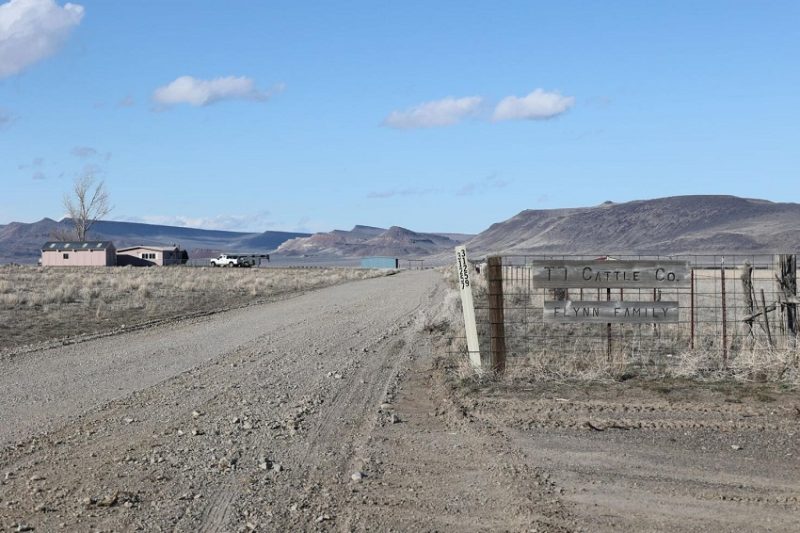VALLEY FALLS, Ore. – Ranchers in Lake County, Oregon, are grappling with significant challenges this winter as a federally protected wolf, OR158, has begun preying on livestock, raising concerns for both ranchers’ safety and the future of their businesses.
The presence of OR158, which was collared by the Oregon Department of Fish and Wildlife (ODFW), marks a new and unsettling chapter for ranchers in the region. Tom Flynn, a rancher at T7 Cattle Ranch, recounted his first encounter with the wolf, describing its large paw prints, which he said were the size of his own hand. After following the tracks, Flynn discovered the wolf eating a five-day-old calf on his property.
“The mother was there, breathing heavy and bawling,” Flynn said. “I’m sure whatever fight she put up before I got there probably pretty well wore her out.”
Since January 30, OR158 has been responsible for killing six calves across two local ranches, including Flynn’s and the Ferrall family’s T Bar Ranch. In one instance, the wolf killed two calves at T Bar Ranch after a federal and state response to scare it off failed. Despite efforts to deter the wolf through non-lethal methods, including the use of fog lights, radios, and increased human presence, the animal has become desensitized to these tactics.
The wolf’s persistent attacks have prompted local ranchers to demand stronger measures. “It’s alarming how bold this wolf has become,” Flynn said. “We’ve been working with the experts, but there’s only so much we can do. This is putting our livelihoods at risk.”
Wolves in this area are federally protected, which means that ranchers are unable to kill the wolf unless it poses a direct threat to human safety. According to ODFW, while the agency takes the situation seriously, it is limited in its ability to address the problem, as the federal government oversees wolf management in this case.
Despite these limitations, ODFW has been working alongside the U.S. Fish and Wildlife Service (USFWS) and USDA Wildlife Services to manage the conflict. These agencies are utilizing hazing and other deterrent methods, but the wolf’s behavior has raised alarm. “Typically, human presence should send a wolf running in the opposite direction,” said an ODFW biologist who reviewed Flynn’s videos. “This behavior is very concerning.”
The ongoing conflict is not only financially devastating but also emotionally taxing for ranchers like Justin Ferrall of T Bar Ranch. Ferrall has reported late-term abortions among his cattle, which he believes may be a result of stress caused by the wolf’s presence. In addition to the stress of managing livestock under these conditions, Ferrall has had to provide extra security measures, including additional personnel and equipment, further stretching his resources.
“I’ve had to bring in extra help, extra vehicles, and work around the clock,” Ferrall said. “It’s taking time away from running the ranch and managing our business. And the costs are adding up. We’re already dealing with tough weather conditions, and now we have to contend with this wolf.”
The situation has extended beyond the ranches. Elise Flynn, who operates a veterinary clinic in the area, expressed concerns for the safety of animals under her care, noting that she can no longer safely hold livestock in pens due to the proximity of the wolf. “It’s terrifying,” she said. “We’re trying to run a business, and the safety of our animals and children has become a constant worry.”
Ranchers are now pushing for the removal of OR158 from the area, hoping for intervention that would allow for the wolf to be relocated to a sanctuary or a zoo. “This wolf isn’t acting like the wolves I’ve read about,” Tom Flynn said. “I’m worried about my children. A wolf doesn’t just go away.”
In response to the growing concerns, the Lake County Commissioners have filed a request with the state for the removal of OR158, a move that has drawn attention to the ongoing tensions between wildlife conservation and agricultural interests. The request was made after the county declared a Public Safety and Livestock Emergency in light of the wolf’s actions.
Governor Tina Kotek is aware of the situation, and while she has expressed support for ranchers, the federal protection status of wolves complicates any removal efforts. The relisting of wolves on the Federal Endangered Species List in 2022 means that any actions to manage the wolves must be approved by the U.S. Fish and Wildlife Service.
On February 20, ODFW released an “Area-Specific Wolf Conflict Plan” outlining the agency’s strategy to handle the situation. The plan focuses on using non-lethal methods and collaborating with federal agencies, though the ongoing attacks have made it clear that more needs to be done.
For ranchers like Tom Flynn and Justin Ferrall, the struggle to protect their livestock is not just a financial burden but a matter of safety. “It only takes one bad encounter for a tragedy to happen,” Flynn said. “I don’t want to find myself in a position where it’s too late to act.”
As the calving season continues and tensions rise, ranchers and wildlife officials are left searching for a solution that balances both the protection of livestock and the preservation of endangered species. However, with OR158’s behavior becoming increasingly unpredictable, the future remains uncertain for Lake County’s ranching community.

